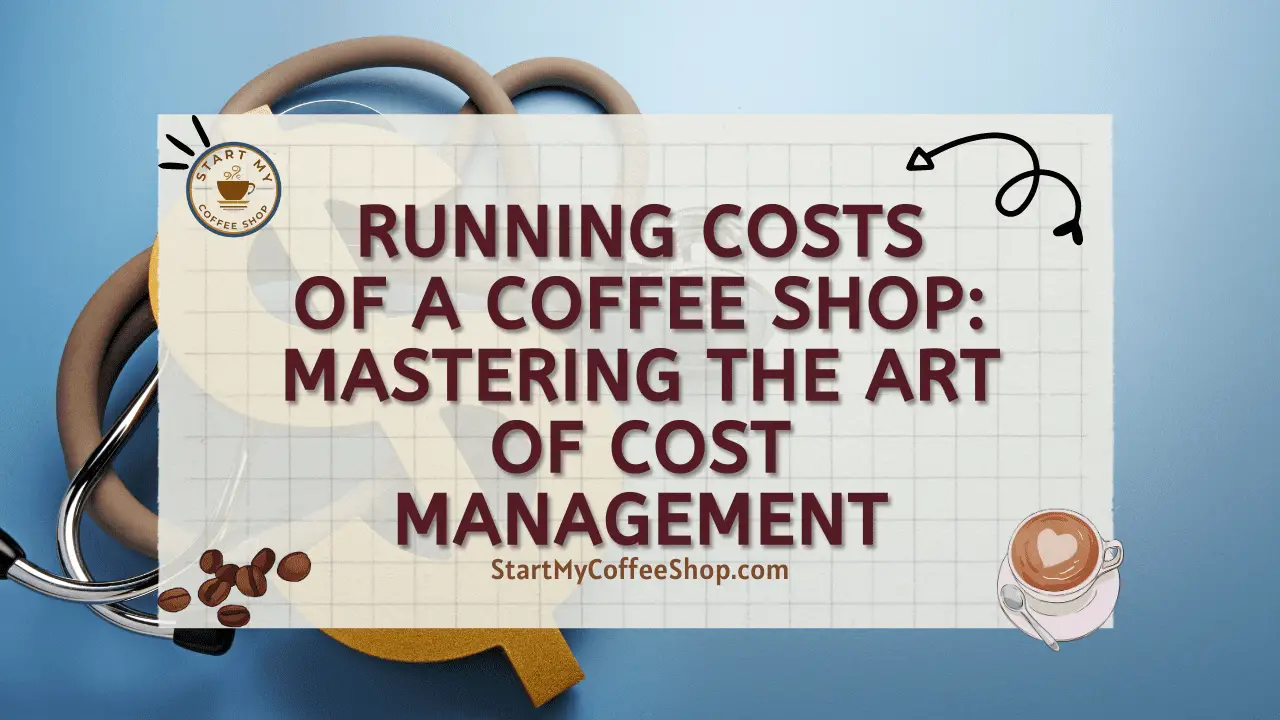Running a coffee shop involves a multitude of costs that owners must carefully manage to ensure profitability and sustainability. From the initial investment to daily operational expenses, understanding and effectively controlling these running costs is crucial for growth in the competitive coffee industry.
Running costs of a coffee shop typically include rent, utilities, labor expenses, ingredients, equipment maintenance, marketing, and administrative expenses. These costs vary based on location, size of the shop, and other factors.
In this article, I will explore the key factors contributing to the running costs of a coffee shop and delve into effective strategies to manage them. By gaining insights into rent, utilities, labor, ingredients, equipment maintenance, marketing, and administrative expenses, coffee shop owners can make informed decisions to optimize their financial performance.
1. Rent and Location
 When embarking on the journey of opening a coffee shop, one of the primary considerations is securing an ideal location. However, this endeavor often comes with a notable price tag. Rental expenses for a coffee shop space depend on various factors, including the size, condition, and desirability of the premises, as well as the local market conditions.
When embarking on the journey of opening a coffee shop, one of the primary considerations is securing an ideal location. However, this endeavor often comes with a notable price tag. Rental expenses for a coffee shop space depend on various factors, including the size, condition, and desirability of the premises, as well as the local market conditions.
To effectively manage running costs, it is essential to strike a delicate balance between finding a location that attracts a steady flow of customers and negotiating favorable lease terms to keep the rent within reasonable limits. Achieving this equilibrium requires thorough market research and analysis to identify areas with high foot traffic and target demographics that align with the coffee shop’s offerings.
Conducting market research helps determine the potential customer base and understand the competition in the area. By gaining insights into consumer preferences and behaviors, coffee shop owners can make informed decisions regarding the ideal location.
Additionally, exploring potential partnerships or shared spaces can provide cost-saving opportunities. Collaborating with complementary businesses, such as bookstores or coworking spaces, allows for shared expenses and can create a mutually beneficial environment.
Negotiating favorable lease terms is another critical aspect of managing rental expenses. This includes considering lease duration, rent escalation clauses, and tenant improvement allowances. Engaging in negotiations with landlords or property management companies can result in more favorable terms, reducing the financial strain on the coffee shop’s budget.
Moreover, it is crucial to assess the condition of the space before finalizing a lease. A thorough inspection can help identify any potential maintenance or renovation costs that may impact the overall budget. Considering these factors beforehand allows for better financial planning and prevents unexpected expenses from disrupting operations.
2. Utilities and Equipment
 Operating a coffee shop entails the use of various equipment, such as coffee machines, grinders, refrigerators, and ovens, all of which consume energy and contribute to utility expenses. However, there are strategies that coffee shop owners can employ to minimize these costs and maximize efficiency.
Operating a coffee shop entails the use of various equipment, such as coffee machines, grinders, refrigerators, and ovens, all of which consume energy and contribute to utility expenses. However, there are strategies that coffee shop owners can employ to minimize these costs and maximize efficiency.
One effective approach is to invest in energy-efficient appliances. Energy Star-certified equipment is designed to consume less energy while maintaining optimal performance. By choosing such appliances, coffee shop owners can significantly reduce their energy consumption and subsequently lower utility bills. Furthermore, energy-efficient equipment often operates more quietly and produces less heat, resulting in a more comfortable and pleasant environment for both customers and staff.
Implementing smart energy management practices is another way to control utility expenses. For instance, utilizing timers can ensure that equipment is only active during operating hours, avoiding unnecessary energy consumption during idle periods. LED lighting, known for its energy efficiency and long lifespan, can replace traditional lighting fixtures, reducing electricity usage without compromising lighting quality.
Regular maintenance and proper usage of equipment are essential in managing running costs. Implementing a preventive maintenance schedule helps identify and address potential issues before they escalate into costly breakdowns.
This includes routine cleaning, calibrations, and inspections to ensure equipment operates efficiently. Training staff on proper equipment usage and maintenance protocols can also minimize the risk of damage and prolong the lifespan of valuable assets.
By prioritizing energy efficiency, adopting smart energy management practices, and maintaining equipment properly, coffee shop owners can achieve substantial cost savings in the long run.
Not only does this contribute to financial sustainability, but it also reflects a commitment to environmental responsibility. Ultimately, the careful management of utility expenses in a coffee shop enhances operational efficiency and supports the overall performance of the business.
3. Labor and Staffing
In the coffee shop business, the quality of service provided by well-trained and motivated staff is paramount. However, labor costs can exert a significant impact on the overall budget. Effectively managing these costs requires careful consideration of various factors.
Determining the optimal staffing levels is essential to balance service quality and labor expenses. This involves analyzing historical sales data, peak hours, and customer flow patterns to identify periods of high and low demand. By aligning staffing levels with customer traffic, coffee shop owners can ensure adequate coverage without overstaffing during slower periods. This approach minimizes unnecessary labor costs while maintaining excellent customer service.
Balancing the mix of full-time and part-time employees is another key aspect of labor cost management. While full-time employees provide stability and continuity, part-time staff offer flexibility in adapting to fluctuating demand.
Finding the right balance between the two can optimize staffing costs while meeting customer needs. Additionally, offering flexible scheduling options can further enhance cost management. Implementing shift rotations, split shifts, or on-call arrangements allows for better control of labor expenses based on anticipated demand.
Investing in staff training programs is a valuable strategy to enhance skills, productivity, and efficiency. Well-trained employees can provide a higher level of service, leading to increased customer satisfaction and loyalty.
Moreover, efficient training programs contribute to reducing errors and improving workflow, ultimately boosting productivity. By equipping employees with
the necessary knowledge and skills, coffee shop owners can minimize service gaps, enhance the overall customer experience, and achieve better financial performance.
Addressing employee retention is crucial in managing labor costs. High turnover rates can be financially detrimental due to recruitment, hiring, and training expenses. Creating a positive work environment, providing competitive compensation packages, and fostering a culture of recognition and growth can help retain talented staff members.
By reducing turnover-related costs, coffee shop owners can allocate resources more efficiently and achieve better long-term financial stability.
Read more about Cost to Start Drive-Thru Coffee Shop: A Cupful of Expenses
4. Ingredients and Inventory Management
Monitoring stock levels is a fundamental aspect of inventory management. By keeping a close eye on inventory levels, coffee shop owners can accurately determine when to restock and avoid overstocking. This helps prevent ingredients from expiring or becoming stale, reducing unnecessary waste and associated costs.
Implementing inventory software can greatly enhance the efficiency of inventory management. These tools provide real-time visibility into stock levels, automate reorder processes, and generate reports for analysis. By leveraging such technology, coffee shop owners can streamline inventory operations, optimize purchasing decisions, and achieve better cost control.
Building strong relationships with suppliers is another critical factor in effective inventory management. Establishing open lines of communication and nurturing mutually beneficial partnerships enable coffee shop owners to negotiate favorable pricing, receive priority during high-demand periods, and access exclusive deals. Maintaining positive relationships with suppliers enhances supply chain efficiency and minimizes the risk of stock shortages or disruptions in ingredient availability.
By implementing efficient inventory management practices, coffee shop owners can strike a balance between avoiding excess inventory and preventing stock shortages. This not only reduces costs associated with waste and stockouts but also ensures a consistent supply chain, allowing the coffee shop to meet customer demand consistently. Effective inventory management contributes to the financial stability of the business and helps maintain the high standards of quality that customers expect.
5. Marketing and Promotion
One cost-effective marketing approach is leveraging social media platforms. With a strong online presence, coffee shops can engage with their target audience, share enticing visuals of their products, and communicate their brand story. By regularly posting engaging content, running promotions or giveaways, and encouraging user-generated content, coffee shop owners can create brand awareness and build a loyal customer base without significant financial investment.
Establishing partnerships with local businesses or organizations is another effective strategy. Collaborating with complementary businesses, such as local bakeries, fitness studios, or art galleries, allows for cross-promotion, expanding the reach of both parties’ customer base. These partnerships can involve joint promotions, loyalty programs, or hosting events together, providing mutual benefits and cost-sharing opportunities.
Community engagement is a powerful and budget-friendly marketing tactic. Participating in local events, sponsoring community initiatives, or organizing charitable activities not only create positive brand associations but also foster meaningful connections with the local community. Word-of-mouth referrals from satisfied customers who appreciate the coffee shop’s involvement in community initiatives can have a substantial impact on brand reputation and customer loyalty.
To ensure efficient resource allocation, it is important to track the ROI of marketing initiatives. By analyzing the performance of different campaigns or promotional activities, coffee shop owners can identify which strategies yield the highest returns and adjust their marketing efforts accordingly. This data-driven approach allows for better decision-making, focusing resources on tactics that have proven to be most effective in reaching and engaging the target audience.
6. Administrative and Miscellaneous Expenses
Careful budgeting and cost analysis are fundamental in managing administrative costs. By creating a comprehensive budget that accounts for all administrative expenses, coffee shop owners can better anticipate and allocate funds for these necessary expenditures. Regularly reviewing and analyzing cost data enables them to identify areas where savings can be achieved without compromising the quality of services or operations.
Exploring cost-saving measures is an effective approach to minimizing administrative expenses. One strategy is to adopt cloud-based software solutions for bookkeeping and administrative tasks. These platforms offer streamlined and efficient processes, reducing the need for manual paperwork and decreasing the time spent on administrative duties. Cloud-based solutions also provide cost savings by eliminating the need for physical storage space and reducing the risk of data loss.
Optimizing insurance coverage is another avenue for cost reduction. By regularly assessing insurance policies and working with knowledgeable insurance providers, coffee shop owners can ensure that their coverage adequately meets their needs at the most competitive rates. Adjusting coverage levels and deductibles based on the specific requirements of the business can help optimize insurance costs without compromising protection.
Periodically reviewing service providers is also essential in managing administrative expenses. By assessing the performance, quality, and pricing of service providers such as accounting firms, IT support, or legal services, coffee shop owners can identify potential cost-saving opportunities. Requesting competitive quotes and negotiating contracts can result in better pricing terms or discovering alternative providers that offer comparable services at lower costs.
Effectively managing administrative costs contributes to the overall financial health of a coffee shop. By implementing budgeting and cost analysis practices, exploring cost-saving measures, and periodically reviewing service providers, coffee shop owners can optimize their administrative expenses without sacrificing the necessary support and services required to operate the business smoothly.
Summary
Effectively managing the running costs of a coffee shop requires a combination of prudent decision-making, strategic planning, and ongoing monitoring. By understanding and controlling expenses related to rent, utilities, labor, ingredients, equipment, marketing, and administration, coffee shop owners can navigate the competitive landscape more effectively and maximize profitability.
Embracing sustainable practices, adopting technological advancements, and fostering a culture of efficiency will contribute to long-term financial viability in the vibrant and evolving world of coffee shop businesses.
Frequently Asked Questions
Q: How can I manage labor costs effectively in my coffee shop?
It’s important to determine optimal staffing levels, balance full-time and part-time employees, and consider flexible scheduling options.
Q: How can I control ingredient costs and maintain quality in my coffee shop?
Monitor stock levels, implement inventory software, and establish strong relationships with suppliers to make informed purchasing decisions.
Q: What are some cost-effective marketing strategies for promoting my coffee shop?
Cost-effective marketing strategies include leveraging social media platforms to engage with customers, partnering with local businesses or community organizations for cross-promotion, and hosting events or workshops to build brand awareness.
To learn more on how to start your own coffee shop checkout my startup documents here
Please note: This blog post is for educational purposes only and does not constitute legal advice. Please consult a legal expert to address your specific needs.

Hi! I’m Shawn Chun
My adventure in coffee began when I first launched my first coffee shop back in the early 2000s. I had to figure out so many things on my own and to make it worse within 2 years of opening two large corporate coffee chains moved in just blocks away from me!
As I saw smaller and even some larger coffee shops in the neighborhood slowly lose customers to these giant coffee chains and slowly close up shop, I knew that I had to start getting creative…or go out of business.
I (like you may be) knew the coffee industry well. I could make the best latte art around and the foam on my caps was the fluffiest you have ever seen. I even had the best state-of-the-art 2 group digital Nuova Simonelli machine money could buy. But I knew that these things alone would not be enough to lure customers away from the name brand established coffee shops.
Eventually, through lots of trial and error as well as perseverance and creativity I did find a way to not only survive but also thrive in the coffee/espresso industry even while those corporate coffee chains stayed put. During those years I learned to adapt and always faced new challenges. It was not always easy, however, in the end, I was the sole survivor independent coffee shop within a 10-mile radius of my location. Just two corporate coffee chains and I were left after that year. All told the corporate coffee chains took down over 15 small independent coffee shops and kiosks and I was the last one standing and thriving.
Along the years I meet others with the same passion for coffee and I quickly learned that it is not only “how good a barista is” that makes a coffee shop successful, but the business side of coffee as well.
Hence why I started this website you are on now. To provide the tools and resources for up and coming coffee shop owners to gain that vital insight and knowledge on how to start a coffee shop successfully.
Stick around, browse through my helpful blog and resources and enjoy your stay! With lots of LATTE LOVE!
Shawn






